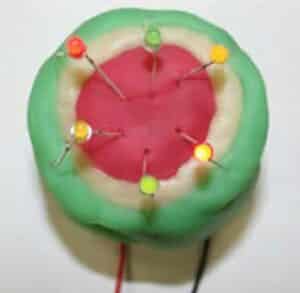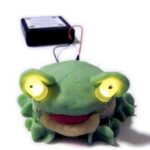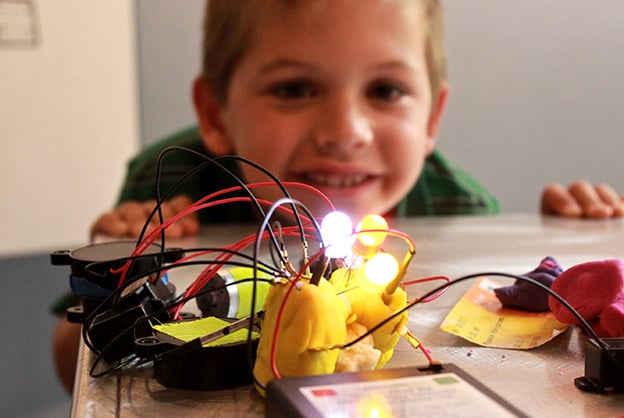Overview
STEM careers
Time
Materials
Per Participant or Per Team:
Note: Materials are also available from squishycircuitsstore.com |
Conductive Dough:
Insulating Dough:
|
Relevant Terminology
Conductor: A material that transmits heat, electricity, or sound.
Current: The rate of flow for an electric charge, or how much electricity is flowing. A strong current means that a lot of electricity is flowing.
Insulator: A material that does not transmit electricity.
Voltage: A force that pushes electrons (as electricity) through a circuit.
Introduce
GETTING READY
Make the conductive dough (with food coloring):

Conductive dough (red and green) and insulating dough (white) used to make a parallel circuit. Credit: University of St. Thomas.
Mix water, 1 cup of flour, salt, cream of tartar, oil, and food coloring in a medium pot. Note: Use the food coloring to designate the conductive dough.
- Cook over medium heat, stirring continuously. The mixture will boil and become chunky.
- Continue stirring until the dough forms a ball.
- Place the HOT ball on a floured surface and allow it to cool for several minutes.
- Knead remaining flour into the ball until it reaches the consistency of play dough.
- Store in an airtight container. Some condensation may appear; this is normal.
Make the insulating dough (no food coloring):
- Mix dry ingredients and oil in a bowl, reserving 1/2 cup of flour.
- Add 1 Tbsp. of distilled water and stir. Repeat until most of the water is absorbed.
- Knead the mixture into one lump.
- Knead more water into the dough until it has a sticky, dough-like texture.
- Knead additional flour into the dough until it reaches the texture of play dough.
- Store in an airtight container. Some condensation may appear; this is normal.
INTRODUCTION

One example of a creature with LED eyes. Credit: Science Buddies.
Any electronic devices you use, like smartphones, game consoles, and even refrigerators, rely on circuits to work. A circuit is a path that electricity flows through. Materials that allow electricity to flow through them are called conductors; materials that electricity can’t flow through are called insulators. Most circuits have a power source (battery), an electrical component (light, motors, or buzzers), and wires that conduct electricity.
Many high-tech devices, from smartphones to satellites, use flexible circuits. Many flexible circuits can be folded, crumpled, or bent and still function properly. Today you will build your own flexible circuit out of conductive play dough!
Instructions
Introduce the design challenge. Participants will use conductive and insulating play dough to build a creature with eyes that light up.
Build a simple circuit:
- Place a lump of conductive dough on each lead of an LED.
- Connect the red wire from the battery pack to one lump of dough and the black wire to the other. If the LED doesn’t light, reverse the red and black wires.
- You can place a lump of insulating dough between the conducting dough to prevent a short circuit.
- Try the same technique for a motor or buzzer.
Plan and build your creature. Think carefully about how you will place conducting and insulating dough in your circuit.
ACTIVITY VARIATIONS
- Use motors or buzzers to add functionality to your creations.
- Combine the squishy circuits with other electrical toys you may have on hand, like Snap Circuits or Lego Mindstorms components.
- Design a switch to control the lights, buzzers, and motors.
TROUBLESHOOTING
- If circuits aren’t working, try reversing the red and black wires, which will switch the polarity.
- If the circuit still isn’t working, check for a short. Place insulating dough between conductive dough in the circuit.
Guiding questions
GUIDANCE FOR YOUNGER CHILDREN
QUESTIONS TO ASK AFTER THE ACTIVITY
- Why is it important that all parts of the circuit are connected?
- What do you think would happen if you tried to connect more than two wires to each battery pack?
- Do you think the size of your creature affects whether or not its eyes light up? Why or why not?
- How would you go about giving your creature three sets of eyes and a way to make a scary sound?
- What would you add to your design to make your creature even better?
GUIDANCE FOR OLDER YOUTH AND ADULTS
QUESTIONS TO ASK AFTER THE ACTIVITY
- How can you modify the design of your circuit to control the flow of electricity to various parts of your creature?
- What other materials might be good conductors of electricity in your creature? What materials might be good insulators?
- What are some other power sources (besides batteries) that can be used to generate electricity? Would they work in your creature? If not, why not?
- How could your device/creature be used in a real-world situation?
Engineering & science connections
GUIDANCE FOR YOUNGER CHILDREN
Engineering Connections
Think about all of the things in your home that run on electricity. All of these items, like televisions, lights, microwaves, video game players, and so much more, have electric circuits inside that make them work. These circuits are all designed by electrical engineers. These engineers start out by thinking about what the device is supposed to do, like show you TV shows or cook your food. Then they start their work by creating drawings, either by hand or with computers, to plan how their circuit will work and what it will look like. From these plans, the engineers build the circuits and then test them to make sure that they work the way they are supposed to. Once all of the problems are fixed and the circuit works just right, they give the circuit to another group of people who mass-produce them, which means “make a lot of them.” Electrical engineers work on many different types of projects, from electronics in your home, to robots, to huge electrical systems that can power entire buildings or even cities!
Science Connections
Every time you flip a light switch, you are using electricity, right? But do you ever wonder what electricity is and where it comes from? Electricity is created by electrons, which are tiny particles that are too small to see. The electrons become electricity when they move from one area or object to another. Electricity is all around us, even in the air. Sometimes we can “see” it, like when we see a bolt of lightning or when we turn on the TV. Sometimes it’s invisible, but we still know that it’s there. Have you ever rubbed your feet on the carpet and then gotten a shock when you touched a doorknob? That’s called static electricity, and it’s caused by those tiny electrons moving from the carpet, to your feet, to the metal doorknob. We can’t see them moving, but that “zap” lets us know that they’re there!
GUIDANCE FOR OLDER YOUTH AND ADULTS
Engineering Connections
Electrical engineers are responsible for designing, building, and testing various types of electronic equipment. Specific projects for which electrical engineers might build circuits include appliances, navigation systems, robotics, computer circuitry, and motors, just to name a few. Just like other engineers, electrical engineers focus on solving problems through design. They must have a strong understanding of mathematics, and frequently use materials such as switches, coils, resistors, magnets, and batteries to make their designs reality. In addition to being able to perform a specific function, the circuits that engineers design must also be reliable and safe to use. Before building a prototype, electrical engineers typically design the circuit on a computer, with the help of a drafting program, so knowledge of specific computer software is also necessary. Consider all of the gadgets and appliances around you that utilize electricity. Chances are that the circuits for those devices were created by electrical engineers.
Science Connections
Electricity is a type of energy created by the flow of electrons, which are one of the three parts of an atom. Atoms are made of protons, which are positively charged, electrons, which are negatively charged, and neutrons, which have no charge. Protons and neutrons compose the center, or nucleus, of the atom, while electrons orbit around it. Typically, atoms have a balanced number of protons and electrons, so their total, or net, charge is neutral. Sometimes, however, electrons move from one atom to another, which changes the charge of the atom. This movement of electrons is called electricity. Like other types of energy, it can be stored, which is called static electricity, or it can move, which is called current electricity. For electrons to flow through a circuit, the circuit must be closed, or complete. When there is a break in a circuit, the electricity cannot flow, and we say the circuit is open. Switches are one example of a device that can be added to a circuit to open and close it, therefore causing it to turn on and off.
Activity adapted from Squishy Circuits Store and the University of St. Thomas. All rights reserved.
Visit squishycircuits.com for additional material and kit related activities.
Supplemental content adapted for Dream Big Activities by Carnegie Science Center.


0 Comments